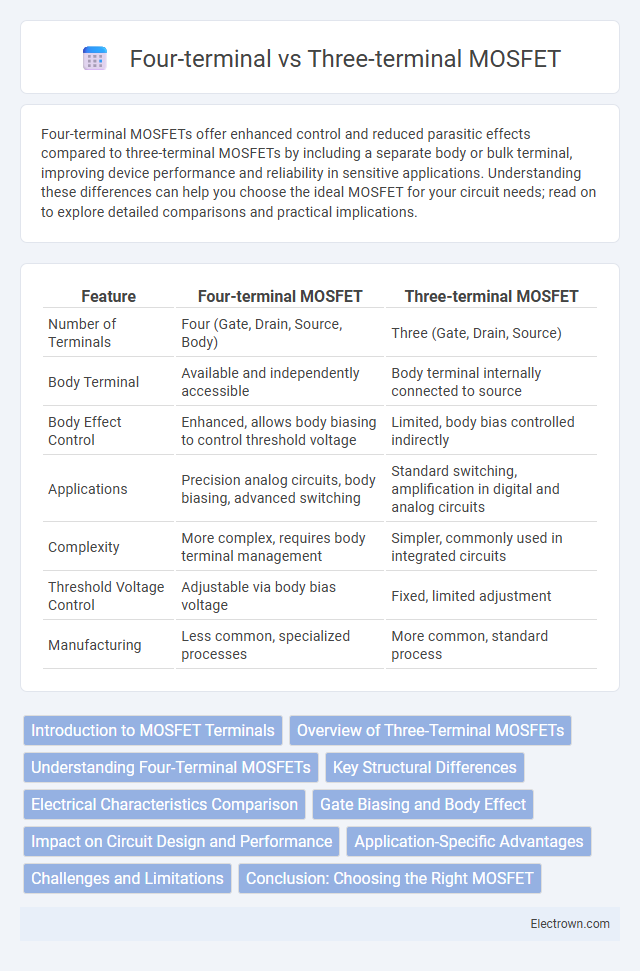Four-terminal MOSFETs offer enhanced control and reduced parasitic effects compared to three-terminal MOSFETs by including a separate body or bulk terminal, improving device performance and reliability in sensitive applications. Understanding these differences can help you choose the ideal MOSFET for your circuit needs; read on to explore detailed comparisons and practical implications.
Table of Comparison
| Feature | Four-terminal MOSFET | Three-terminal MOSFET |
|---|---|---|
| Number of Terminals | Four (Gate, Drain, Source, Body) | Three (Gate, Drain, Source) |
| Body Terminal | Available and independently accessible | Body terminal internally connected to source |
| Body Effect Control | Enhanced, allows body biasing to control threshold voltage | Limited, body bias controlled indirectly |
| Applications | Precision analog circuits, body biasing, advanced switching | Standard switching, amplification in digital and analog circuits |
| Complexity | More complex, requires body terminal management | Simpler, commonly used in integrated circuits |
| Threshold Voltage Control | Adjustable via body bias voltage | Fixed, limited adjustment |
| Manufacturing | Less common, specialized processes | More common, standard process |
Introduction to MOSFET Terminals
MOSFETs typically have three terminals: gate, drain, and source, which control current flow and device operation. Four-terminal MOSFETs include a substrate or body terminal that provides an additional connection for controlling the threshold voltage and minimizing parasitic effects. The presence of the body terminal in four-terminal MOSFETs enhances device performance and enables precise modulation of electrical characteristics in integrated circuits.
Overview of Three-Terminal MOSFETs
Three-terminal MOSFETs, comprising gate, drain, and source terminals, are fundamental components in digital and analog circuits for switching and amplification purposes. The absence of a dedicated body or substrate terminal in three-terminal MOSFETs simplifies integration but can introduce body effect, impacting threshold voltage stability. These devices are widely used due to their straightforward design, ease of control, and compatibility with standard CMOS processes.
Understanding Four-Terminal MOSFETs
Four-terminal MOSFETs include an additional substrate or body terminal compared to three-terminal MOSFETs, enabling enhanced control over the device's threshold voltage and body effect. This extra terminal allows independent biasing of the body, improving device performance in analog and low-noise applications by reducing leakage currents and mitigating the body effect impact. Understanding four-terminal MOSFETs is essential for integrated circuit design where precise control of transistor parameters is critical for optimizing switching speed and power efficiency.
Key Structural Differences
Four-terminal MOSFETs feature an additional body or substrate terminal separate from the source, drain, and gate, allowing better control of the body effect and reduction of threshold voltage variations. Three-terminal MOSFETs combine the body terminal with the source, simplifying the structure but limiting the ability to independently manage the substrate bias. Understanding these key structural differences helps optimize your circuit design for threshold voltage stability and improved device performance.
Electrical Characteristics Comparison
Four-terminal MOSFETs feature a separate body or substrate terminal, allowing precise control over body effect and improved threshold voltage modulation compared to three-terminal MOSFETs, which combine the body and source terminals. The additional terminal in four-terminal MOSFETs reduces parasitic capacitance and enhances switching speed, making them suitable for high-frequency applications. Three-terminal MOSFETs offer simpler design and lower cost but exhibit higher body effect and threshold voltage variability impacting leakage current and on-resistance characteristics.
Gate Biasing and Body Effect
Four-terminal MOSFETs feature a separate body (substrate) terminal allowing independent gate biasing and direct control over the body effect, which impacts threshold voltage and device performance. In contrast, three-terminal MOSFETs tie the body terminal to the source, limiting gate biasing flexibility and causing stronger body effect influence. Understanding this distinction helps optimize Your circuit design for reduced threshold voltage variation and improved switching characteristics.
Impact on Circuit Design and Performance
Four-terminal MOSFETs include an additional substrate or body terminal, allowing precise control over body effect and threshold voltage modulation, which improves circuit stability and reduces leakage currents in analog and RF applications. Three-terminal MOSFETs, lacking a separate body terminal, simplify design and reduce component count but can suffer from unpredictable body effects, impacting switching speed and threshold voltage consistency in digital circuits. Choosing between the two affects circuit biasing strategies, parasitic capacitances, and overall device reliability in high-performance and low-power applications.
Application-Specific Advantages
Four-terminal MOSFETs offer enhanced control and precision in high-frequency and analog signal applications, making them ideal for RF circuits and sensitive measurement equipment. Three-terminal MOSFETs provide simplicity and cost-effectiveness, well-suited for digital switching and general-purpose amplification tasks. Your choice depends on whether you prioritize advanced control features or straightforward implementation in your electronic design.
Challenges and Limitations
Four-terminal MOSFETs face complexity in packaging and increased parasitic capacitances, impacting high-frequency performance and thermal management. Three-terminal MOSFETs, while simpler and more common, encounter limitations in controlling substrate effects and body diodes, which can cause latch-up and reduce reliability in certain circuits. Your design choices must balance these trade-offs based on application-specific requirements such as switching speed, power dissipation, and circuit integration.
Conclusion: Choosing the Right MOSFET
Selecting the right MOSFET depends on the application requirements: four-terminal MOSFETs offer enhanced control and diagnostic capabilities due to their separate body terminal, making them ideal for high-precision and complex circuits. Three-terminal MOSFETs provide simplicity and cost-effectiveness, suitable for general switching and amplification tasks. Engineers prioritize four-terminal devices in power management and safety-critical systems, while three-terminal MOSFETs remain popular in standard consumer electronics and low-cost designs.
Four-terminal vs Three-terminal MOSFET Infographic

 electrown.com
electrown.com